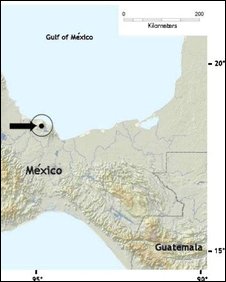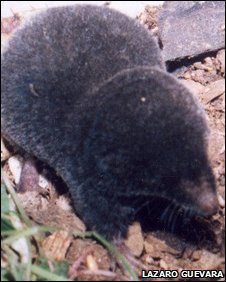Veracruz: Extinct Shrew Rediscovered, Bridge Collapses
Posted by: Loren Coleman on July 17th, 2009
You know what they say. When it rains, it pours.
A tiny species has been rediscovered in the wild, more than a century after first being described, drawing attention to Veracruz, and the next day, more breaking news comes from that same corner of Mexico.
In 1894, a handful of specimens of the Nelson’s small-eared shrew were collected in southern Mexico.
But the shrew was never seen again, and was considered by many experts to already be extinct.
That was until two researchers found three shrews in a small patch of forest, a find that is reported in the journal Mammalian Biology.
The Nelson’s small-eared shrew (Cryptotis nelsoni) is named after the man who first discovered it.
In 1894, Edward Nelson and Edward Goldman collected 12 specimens some 4,800 feet up the slopes of the San Martín Tuxtla volcano in Veracruz, Mexico.
A year later, the creature was formally described for science, and the specimens were stored away in the drawers of the National Museum of Natural History in Washington DC, US.
Mammalogist Lazaro Guevara rediscovered the species that was seen alive 109 years ago.

The shrew’s last stronghold, in the forests of Veracruz, Mexico
For more, see, “‘Extinct’ tiny shrew rediscovered,” Matt Walker, July 16, 2009.
Meanwhile, on July 17, 2009, more news from Veracruz, although it does not appear to involve the shrew or Mothman, yet.
Three people were missing Friday after four vehicles plunged into a river when a bridge collapsed in southeastern Mexico, an official told CNN en Español.
The occupants of the fourth vehicle swam to the riverbank, where they were rescued, said Ranulfo Marquez, secretary of civil protection in the state of Veracruz.
Officials did not give a cause for the bridge collapse. Three of the vehicles were tractor-trailers, the government-run Notimex news agency said.
The bridge spans the Tonala River outside the city of Agua Dulce in the state of Veracruz.
My thanks to Red Pill for the breaking heads up about the bridge collapse. Check back for updated info.
About Loren Coleman
Loren Coleman is one of the world’s leading cryptozoologists, some say “the” leading living cryptozoologist. Certainly, he is acknowledged as the current living American researcher and writer who has most popularized cryptozoology in the late 20th and early 21st centuries.
Starting his fieldwork and investigations in 1960, after traveling and trekking extensively in pursuit of cryptozoological mysteries, Coleman began writing to share his experiences in 1969. An honorary member of Ivan T. Sanderson’s Society for the Investigation of the Unexplained in the 1970s, Coleman has been bestowed with similar honorary memberships of the North Idaho College Cryptozoology Club in 1983, and in subsequent years, that of the British Columbia Scientific Cryptozoology Club, CryptoSafari International, and other international organizations. He was also a Life Member and Benefactor of the International Society of Cryptozoology (now-defunct).
Loren Coleman’s daily blog, as a member of the Cryptomundo Team, served as an ongoing avenue of communication for the ever-growing body of cryptozoo news from 2005 through 2013. He returned as an infrequent contributor beginning Halloween week of 2015.
Coleman is the founder in 2003, and current director of the International Cryptozoology Museum in Portland, Maine.











In this world there are regions who seem to suffer from a really “bad luck” when compared to others. Indonesia is one of those places; now Veracruz seems to be entering that category.
The reason I say this, is because a few months ago it was precisely in Veracruz where the first confirmed case in the world of swine flu was reported, just a few months ago —in the area of Perote, to be precise.
I’m not claimng that there’s a connection; just that, well… like Loren says: when it rains, it pours —although right now it seems rather like a flood! :-/
Lessee… what’s part of the species name? Oh, yeah – “crypto”. It seems to have lived up to its name rather well, staying hidden for more than a century – wonder if they’ll be seen again in my lifetime?
awww….i think its cute